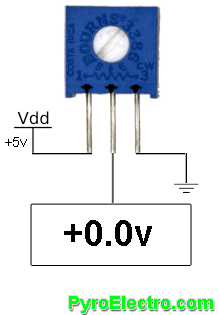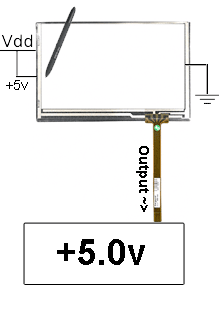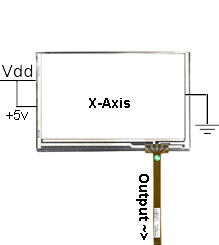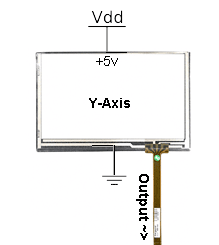16x2 LCD Theory
In this theory section, we'll take a look at how the touch screen works. First we'll draw a comparison between the standard variable resistor trimmer and one axis of the touch screen. Then we'll look at the two axes (that's axis but pural) problem and how we get information for each one.
Variable Resistor vs. Touch Screen


The variable resistor (trimmer) that is extremely common throughout electronics outputs a static voltage depending on the current resistance setting. The resistive touch screen operates in a similar way. If we touch a point in the middle of the screen, it acts as if a trim-pot is set to the very middle resistance setting, thus outputing 1/2 the input voltage. The image above illustrates this effect across the entire screen.
Two Axis: Two Problems


The comparison above works well and we could send the output signal from the touchscreen to an Analog to Digital converter and find out where the screen is being touched except that data would only be for 1 axis. The touchscreen has two axis, X and Y. The illustration above shows that we must actually get the axis data from one axis at a time and then use that information together to know the exact point on the screen that was touched. So 2 analog to digital conversions must take place, one for each axis of the screen.
In this theory section, we'll take a look at how the touch screen works. First we'll draw a comparison between the standard variable resistor trimmer and one axis of the touch screen. Then we'll look at the two axes (that's axis but pural) problem and how we get information for each one.


The variable resistor (trimmer) that is extremely common throughout electronics outputs a static voltage depending on the current resistance setting. The resistive touch screen operates in a similar way. If we touch a point in the middle of the screen, it acts as if a trim-pot is set to the very middle resistance setting, thus outputing 1/2 the input voltage. The image above illustrates this effect across the entire screen.


The comparison above works well and we could send the output signal from the touchscreen to an Analog to Digital converter and find out where the screen is being touched except that data would only be for 1 axis. The touchscreen has two axis, X and Y. The illustration above shows that we must actually get the axis data from one axis at a time and then use that information together to know the exact point on the screen that was touched. So 2 analog to digital conversions must take place, one for each axis of the screen.